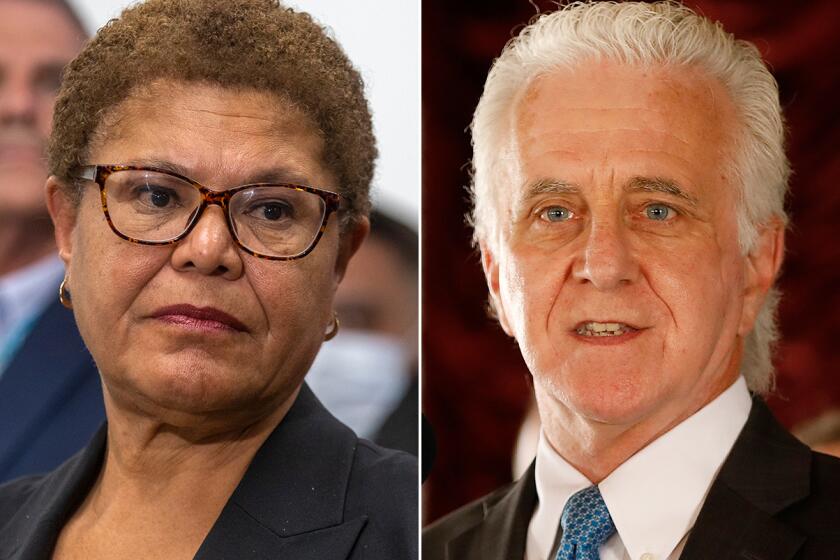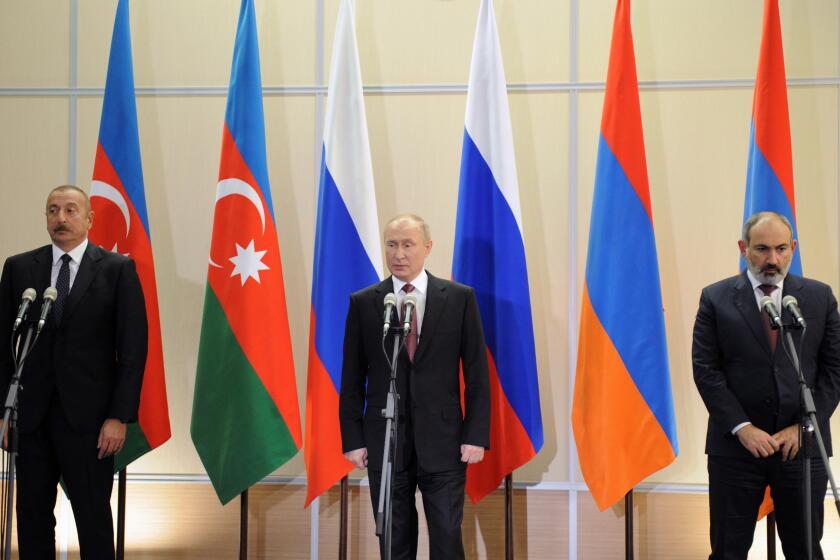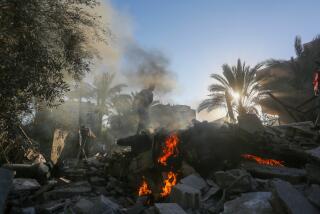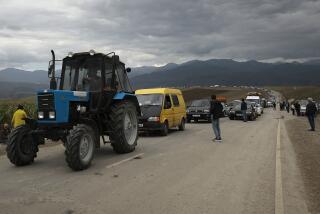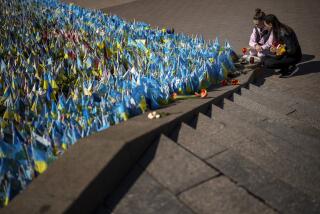Op-Ed: We can’t let history repeat itself with the siege of Nagorno-Karabakh
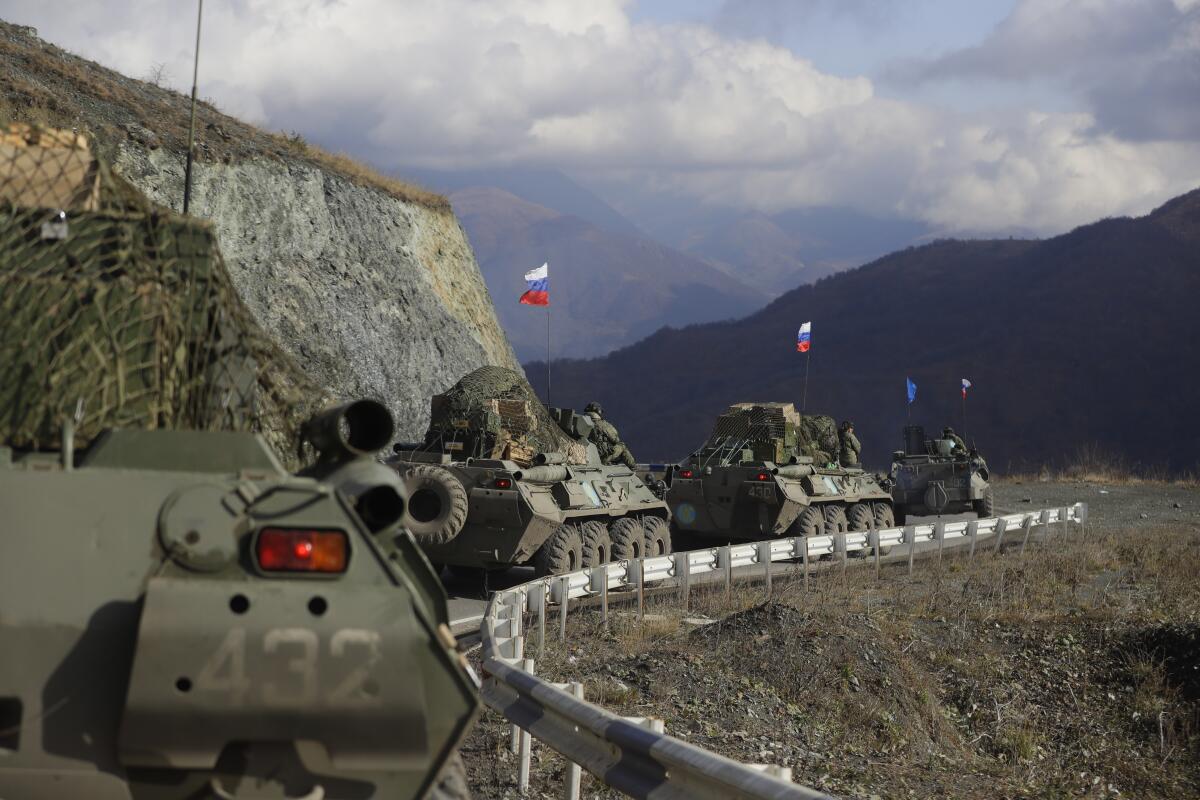
- Share via
The world watched and allowed a brutal genocide three decades ago in the Bosnian city of Srebrenica. A tragically similar crisis is looming again. Global leaders know how this could end, and they have no excuse to stand by. Indeed, they are bound by law and human decency to intervene and protect the 120,000 civilians in the Armenian-majority Republic of Artsakh.
Upon the breakup of the former Yugoslavia 30 years ago, Bosnia declared independence. The Serbian central government responded by launching a brutal military campaign to crush Bosnia’s attempt at self-determination.
The conflict reached a critical point with the siege of Srebrenica, whose residents included a Bosnian self-defense force and many civilians. During the siege, the United Nations provided some emergency supplies, but hardly enough to meet the needs of the besieged population. Following a period of starvation, in July 1995 Serbian forces entered the city and began killing civilians. The Srebrenica genocide was underway.
The Los Angeles area is home to the largest concentration of Armenians outside of Armenia, a diaspora with deep roots in the city.
Later trials at the International Court of Justice affirmed that this was genocide, and the Dutch Supreme Court held the Netherlands responsible for some of the deaths for not trying hard enough to stop the killings.
Around the time Bosnia declared independence, the Soviet Union was collapsing and Soviet republics declared their own independence. An autonomous enclave within Soviet Azerbaijan known as Nagorno-Karabakh, which had a majority-Armenian population, also declared its intention to exercise its right to self-determination.
The Armenians of Nagorno-Karabakh, a minority group within Soviet Azerbaijan, were subjected to decades of abuse and pogroms. Following the enclave’s declaration of independence, with eerie echoes of events unfolding in Bosnia, the Azeri government mounted a similar operation of ethnic cleansing and launched an attack on the enclave’s Armenian population.
Days before invading Ukraine, Putin signed an agreement with Azerbaijan that set the stage for a humanitarian crisis.
After several years of war, the Nagorno-Karabakh Armenians prevailed and in 1995 formed an independent democratic state known as the Republic of Artsakh, based on the ancient pre-Stalin name of the region. For the next 25 years, the unrecognized democratic Republic of Artsakh engaged effectively with international institutions and European oversight bodies to enhance governance and civil society infrastructure. Four presidents were elected, with the elections monitored by European nongovernmental organizations. A vibrant press operated freely, and a spectrum of political parties participated in the local parliament.
During this same period, Azerbaijan embraced authoritarianism, becoming a petro-dictatorship governed by one family from 1993 to today. Azerbaijan now ranks 167th out of 180 in the most recent Reporters Without Borders ranking for press freedoms. Human Rights Watch has called the human rights situation in Azerbaijan “appalling,” with the government “severely curtailing freedoms of association, expression, and assembly” and “torture and ill-treatment” of journalists, lawyers and opposition activists. Azerbaijan also has nurtured a culture of “Armenophobia” in its schools and state institutions and was sanctioned by the International Court of Justice for this practice.
In 2020, emboldened with oil and gas revenue, Azerbaijan launched a successful attack on Artsakh. With direct involvement of Turkey, Azerbaijan succeeded in overrunning most of the territory controlled by the Armenians. The war ended with a truce brokered by Russia that left Artsakh on a fraction of its historic territories, a single land corridor linking it to Armenia and the outside world. Since the 2020 peace agreement, this Lachin corridor has been monitored by Russian peacekeepers to secure the transport of people and goods in and out of the enclave.
On Dec. 12, 2022, with war escalating in Ukraine, the Azerbaijani government launched a siege against Artsakh’s Armenian population by blocking the Lachin corridor, inflicting collective punishment on 120,000 civilians. The monthlong siege has resulted in the closing of schools, severe food shortages, and rationing of electricity and natural gas for heating. Essential medications are now scarce, families have been separated, hospital patients in need of critical treatment have died. Other than the occasional shuttling of critically ill patients out of the region through the help of the Red Cross, Azerbaijan has blocked all movement in and out of Artsakh.
The parallels with the siege of Srebrenica are haunting. The Azerbaijani dictator, Ilham Aliyev, stated in a TV interview on Jan. 10 that his government aimed to depopulate the region of the Armenians of Artsakh. These statements and the blockade of the Lachin corridor led a group of scientists and academics to declare: “As scholars studying the genocide process, we believe that the actions of the Azerbaijani government pose a threat of genocide to Armenians in the region.”
This impending catastrophe is deservedly drawing attention: The European Court of Human Rights applied interim measures against Azerbaijan over this blockade; the Council of Europe Commissioner for Human Rights called for its urgent lifting; and Amnesty International, the European Union, Brazil, France, Germany, Greece, the Helsinki Commission, the Netherlands, Norway, Spain, Switzerland, the United States and USAID have each separately called for the immediate lifting of the siege. And yet no concrete intervention is on the horizon.
As the world learned in Srebrenica, inaction is complicity. The siege against the Armenian population of Artsakh is a crime against humanity and a prelude for genocide. Signatory nations of the Geneva Convention of 1948 are legally required to intervene before it is too late.
More than 160 scholars recently signed a public statement demanding intervention through immediate airlifts of supplies; creation of an international mandate for Artsakh to protect the local population from ethnic cleansing and genocide; and economic sanctions targeting the corrupt ruling elite in Azerbaijan.
Artsakh today is the face of the conflict between democracy and autocracy, transparency and corruption, and freedom and oppression. The parallels with Srebrenica should end now. The world cannot pretend ignorance. Failure to protect Artsakh’s civilian population is complicity in its destruction.
Mary Papazian is a former president and professor of English at San Jose State University. Vatche Sahakian is a professor of theoretical physics at Harvey Mudd College and a visiting professor at Caltech.
More to Read
A cure for the common opinion
Get thought-provoking perspectives with our weekly newsletter.
You may occasionally receive promotional content from the Los Angeles Times.
